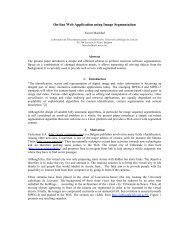motion estimation and compensation for very low bitrate video coding
motion estimation and compensation for very low bitrate video coding
motion estimation and compensation for very low bitrate video coding
Create successful ePaper yourself
Turn your PDF publications into a flip-book with our unique Google optimized e-Paper software.
14 Chapter 1. Digital Video Coding at Very-Low BitRate<br />
Finally, the state of the art of <strong>video</strong> <strong>coding</strong> is discussed <strong>and</strong> some new<br />
investigations in image analysis are introduced.<br />
1.1 Digital Video<br />
Digital images or frames consist of luminance (i.e. the brightness) <strong>and</strong><br />
chrominance (i.e. the colors) intensities of regularly sampled points<br />
(the picture elements 1 ). The sampling process is per<strong>for</strong>med either on<br />
a natural scene (digital camera) or on an \analog" image (digital scanning).<br />
The spatial in<strong>for</strong>mation (in the two-dimensional space) is characterized<br />
by the image resolution. Instead of characterizing this resolution<br />
in pel=cm or pel=inch, it is generally expressed as the product<br />
pels=line lines, which is a measure independent from the screen size. A<br />
(digital) <strong>video</strong> sequence is a succession of (digital) images whose characteristic<br />
is the temporal resolution in terms of frames=s or images=s.<br />
This temporal domain in<strong>for</strong>mation (the changes of image intensity along<br />
the time axis) is speci c to <strong>video</strong> transmission <strong>and</strong> raises the problems<br />
addressed in the present thesis, namely <strong>motion</strong> <strong>estimation</strong> <strong>and</strong> <strong>compensation</strong>.<br />
In its Recommendation 601 [12], the ITU-R (International<br />
Telecommunication Union - Radiocommunication, <strong>for</strong>merly CCIR) has<br />
de ned a way to digitize images in st<strong>and</strong>ard <strong>for</strong>mat (720 576). An extension<br />
of this de nition provides one with the di erent resolutions which<br />
should be used according to the target application (table 1.1), which directly<br />
introduces the required <strong>bitrate</strong> if no compression is achieved.<br />
Application Luminance Chrom. Aspect Temporal Bitrate<br />
resolution resolution ratio (fr:=s) (Mbit=s)<br />
HDTV 1920 1152 960 576 16=9 50 1800<br />
TV (broad.) 720 576 360 576 4=3 25 166<br />
TV (CD rec.) 360 288 180 144 4=3 25 31<br />
Video phone 360 288 180 144 4=3 10 12:4<br />
Mobile <strong>video</strong> 180 144 90 72 4=3 5 1:6<br />
Table 1.1: CCIR 601 <strong>for</strong>mats <strong>for</strong> moving pictures applications<br />
A few remarks can be made concerning table 1.1. At rst, the spatial resolution<br />
of the chrominance components is <strong>low</strong>er than the luminance one.<br />
1 Commonly abbreviated as \pixels" or\pels".





